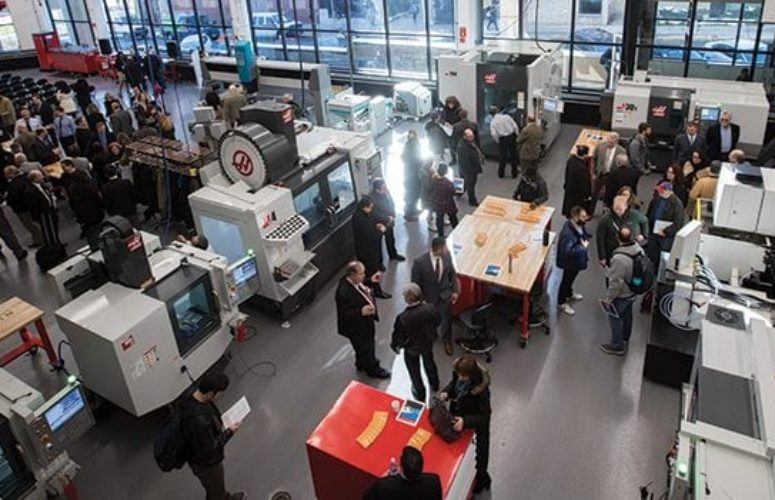
Manufacturing Skills for Today
Manufacturing floors may include a range of older, time-tested technologies, as well as cutting-edge equipment; skilled workers are needed.
By George N. Saliba, Managing Editor On Feb 1, 2018Contrary to a persistent yet reality-bending myth, a staggering swath of manufacturing indeed remains in the United States, and we are the largest manufacturing country in the world, second only to China. Even here in New Jersey, where the cost of conducting business may be higher than in other states, more than 11,000 manufacturing companies dot the landscape, ranging from machine-shop-style operations to high-tech endeavors with cutting-edge technology. And while these companies face many challenges, among them is finding qualified workers: high school guidance counselors often don’t know that manufacturing is – and will likely remain – a well-paying career path, and this creates a dearth of students pursuing it, and, in turn, trained workers. Also, older manufacturing workers are set to retire.
According to the National Association of Manufacturers, the average annual salary for manufacturing workers in New Jersey is approximately $90,000, a leap beyond the state’s medium salary of approximately $56,000. And while manufacturing “robots” may be evolving, they will not soon create the “factory floor of the future,” which, to paraphrase the author Warren Bennis, would consist of one man and one dog (the man would be there to feed the dog, and the dog would be there to keep the man away from the computers).
When talking about the current and future demand for manufacturing workers and “robots,” John W. Kennedy, CEO of the New Jersey Manufacturing Extension Program (NJMEP) declares, “I think we like to scare ourselves” – he, instead, sees a need for workers.
He explains, “What is happening is that the machinist of a few years back is now a machinist with some IT background. And that’s prevalent throughout the entire industry. There is some robot-assist that has been coming in, but a lot of the smaller firms don’t get into pure robotics at this point in time, and even some of the larger ones, because depending on what things they are doing, they can’t justify the cost of millions of dollars for robots …
“The interesting factor for many companies is that you need people who have the skills to understand the machinery, but that person also has to come with a little computer chip as well. That is the way it is evolving.”
Adapting to a Company’s Environment
Clifford Lindholm, president and CEO, Falstrom Company, says, “Finding people with the right set of skills for any company, [including] Falstrom company, continues to be a real challenge. And in manufacturing, specifically, it becomes a challenge because most manufacturers have a niche that they are working in. As a result, there is a set of skills that is particular to that company. … That applies whether you are on the production line and on the manufacturing floor, or whether you are working in administration, for example, or engineering. It can potentially [affect] accounting, marketing and sales.”
Lindholm notes, “For example, we can find welders who have received training at a welding school, at one of the vocational schools, or perhaps some kind of county college welding training. But, once they come to Falstrom Company, we have to spend time giving them additional training, on-the-job experience, and coaching, to help them be successful at welding and fabricating the products that we make.”
More specifically, Lindholm adds, “On the production floor, it is years before someone can really be a good, skilled welder, or assembler. With welding, in particular, it takes years to become familiar with the product. It also takes years to build up a set of credentials; we have to be certified to certain weld procedures, in our business. From an assembly point of view, learning to read blueprints in a way that you can fully understand what they are telling you; that is a skill that is not easily taught in school. In fact, it is rarely taught in school, to the level of detail that we need on floor. That is also a skill that takes years to develop.”
Lindholm says that after two or three years, the worker may have some competency, but to be a superior craftsman might take between 5 to 10 years.
A Range of Needed Skills
At one level of the skill-set spectrum are professionals such as mechanical or manufacturing engineers, who are trained in everything ranging from thermal energy management and fluidics, for example, to 3-D printing. Engineers may work in production facilities; they may also be engaged in the “knowledge work” in manufacturing, and management of the manufacturing process. Kishore Pochiraju, professor in the mechanical engineering department, and associate dean for undergraduate studies, Stevens Institute of Technology, says, “These days there is a healthy mix of both the knowledge work as well as production work. A lot of aerospace companies and precision manufacturing companies have their production facilities onshore; they have it in New Jersey, and in this [geographical] area. Those engineers – they work on the factory floor; they are solving day-to-day problems.
“We see very, very niche companies in New Jersey. We have an aerospace company that produces evacuation systems, that has a lot of Stevens engineers; they work on the factory floor; they work everywhere in the whole manufacturing cycle; they are going to offshore factories to manage problems and to troubleshoot. They are working on the design end of things, so they are everywhere in the production loop.”
At another end of the skill-set spectrum are individuals with no prior experience in manufacturing. In fact, Raymond Vaccari, director of the Advanced Manufacturing Talent Network for the state of New Jersey, a program funded by the State Department of Labor, and hosted at NJIT, says one manufacturer has to evaluate job candidates by giving them a wooden ruler and asking them to indicate where “one inch and five eighths” is on the ruler. This is a far cry from the evaluation process facing a person applying as a skilled tool-and-die maker or welder.
Employability Skills
Above and beyond the technical skills necessary to work on a manufacturing floor, so-called “employability skills” are an imperative as well: The ability to arrive at work on time, perform the required tasks, and to follow instructions. Vaccari says, “[Here is] a quote from a manufacturer: ‘Just give me someone who can show up to work on time and take instructions from a boss, and I will train them.’ That’s a common theme among a lot of people. … The basic skills are the soft skills. It is the work ethic; it is just being able to dress properly, being able to communicate; and being able to work as a team member.”
Of note, military veterans are often perfect candidates for the manufacturing world: Discipline has been ingrained in them, and, additionally, the military often provides training on a wide range of technical matters that are transferable to manufacturing environments. Vaccari says, “Any manufacturer we talk to, when we mention the military veterans, they are excited: ‘Yes, show them to me; bring them here. I will hire them.’”
College Graduates / Women
Although the broader labor market across sectors has improved, depending on their academic majors, some college graduates are more in demand than others, and, additionally, students may graduate with thousands of dollars in debt – and with no clear job prospects. In some cases, a manufacturing job may be appropriate, since the wages are steady and the graduates already have demonstrated an ability to learn. Gale Tenen Spak, associate vice president for continuing professional education at NJIT, and the prime contact on the Advanced Manufacturing Talent Network, says, “College alumni, who are in such situations … are huge candidates for working in manufacturing, because the college student will have taken math, regardless of his or her major. Math is so important to any of the more sophisticated positions and jobs in manufacturing. And here we have men and women who we don’t necessarily want to get another degree, if they are alumni of a college. But, we can easily teach them the technical knowledge and skills … and we can help them earn what Ray referred to earlier as industry-valued credentials.”
Separately, she adds, “It is not the same in every state in America, but in New Jersey, with our vast majority of small [manufacturing] firms, if a woman decides to go into this career, and is taking a job in a small firm, it is an easier glass ceiling to break through. There are fewer obstacles.”
Conclusion
New Jersey is a node for life sciences companies, for example, with approximately 350 biotech companies alone, here. Additional firms in telecommunications, chemicals, industrial real estate and defense make our state an innovation epicenter. Yet those sectors and industries are evolving, and so too is our manufacturing arena. As Gale Tenen Spak says, “You have to think about the smaller manufacturing companies, which is the majority of our companies in manufacturing, as the supply chain to the big corporations. They make the components. You can’t manufacture an airplane without the right components. That is what we still have in New Jersey: You need the welders, machinists and CNC operators, because you can’t make these parts [without them]. That is the supply chain issue. And we are the supply chain in the state. We are not really even the medicine cabinet of the world, anymore, because the manufacturing in pharma, is not here. This is the truth of what is going on, but it is not unimportant that we make components, here, because the big corporations, including those abroad, need these products.”
More broadly, Lindholm concludes, “Manufacturing is having a significant impact on the New Jersey economy. Nationally, if you look at some of the data, whether it is regional surveys from the Federal Reserve Bank of New York, or what used to be called the purchasing manager’s index or PMI, those indices show that the manufacturing sector of the economy is booming, right now. … Now is the time to get into manufacturing, because we are certainly having a real ride on the upcycle. It’s an exciting time to be in manufacturing.”
Related Articles:






